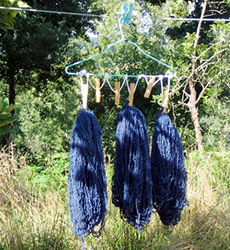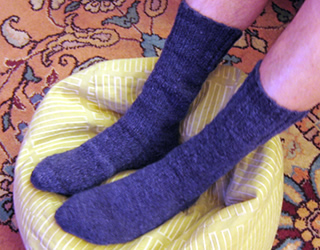« La Baie du Mont-Saint-Michel | Main | Feeling blue - part II »
Friday August 15, 2008
Feeling blue - part I

Blue grass, blue floor, blue cooker - blue everything basically.
My knowledge about dyeing advanced in leaps and bounds while I was in France. Sheila gave me an old Dylon pod just before I went, (Riviera Blue), which turned out to be a cold water dye and needed a "fixer". On reading up about this I found it's a reactive dye and the fixer is sodium carbonate or soda ash. I know alkali is bad for wool - and I had no fixer - so I pondered getting some and experimenting. Luckily, I was able to read all about what to do on this great website under the section "Fiber reactive dyes on protein fibers". Basically use acid (vinegar) instead of sodium carbonate.
So I cooked up a bath for my newly plied skeins. Here was the result:

I was especially pleased, as at one point I accidentally boiled the dye bath - but the Suffolk wool skeins seemed to cope OK. I resisted the temptation to panic, and avoided poking them, and allowed them to cool slowly in the bath before rinsing.
I had thought I had cracked this spinning lark (har har I hear you laugh) so was a bit sad that I still had very uneven twist and artistic wobbly yarn. However, the yarn picked up the colour unevenly to produce a rather nice tweedy effect.
Finally I went on to knit it into a pair of socks - again, a slight disappointment that my very thin 2 ply is still almost a double knit (worsted weight). But I am getting there. The uneven colour lines are produced as I changed over my spun bobbins, and purely to do with the colour absorption, not a change of skein.

After this success, I bought another reactive black dye in the French supermarket and tried that on my fleece; it produced a much better result than the Dylon all-purpose. I am unsure if this is inherent in the dye type or was due to my increasing experience. The only negative point here is that it is quite expensive dying black - you need about twice as much dye per weight of wool than for other colours (about one pack for 100g).
Posted by Christina at 4:57 PM. Category: Spinning, Dying, Weaving
